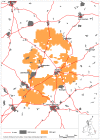Building development and roads: implications for the distribution of stone curlews across the Brecks
- PMID: 24023662
- PMCID: PMC3758259
- DOI: 10.1371/journal.pone.0072984
Building development and roads: implications for the distribution of stone curlews across the Brecks
Abstract
Background: Substantial new housing and infrastructure development planned within England has the potential to conflict with the nature conservation interests of protected sites. The Breckland area of eastern England (the Brecks) is designated as a Special Protection Area for a number of bird species, including the stone curlew (for which it holds more than 60% of the UK total population). We explore the effect of buildings and roads on the spatial distribution of stone curlew nests across the Brecks in order to inform strategic development plans to avoid adverse effects on such European protected sites.
Methodology: Using data across all years (and subsets of years) over the period 1988-2006 but restricted to habitat areas of arable land with suitable soils, we assessed nest density in relation to the distances to nearest settlements and to major roads. Measures of the local density of nearby buildings, roads and traffic levels were assessed using normal kernel distance-weighting functions. Quasi-Poisson generalised linear mixed models allowing for spatial auto-correlation were fitted.
Results: Significantly lower densities of stone curlew nests were found at distances up to 1500m from settlements, and distances up to 1000m or more from major (trunk) roads. The best fitting models involved optimally distance-weighted variables for the extent of nearby buildings and the trunk road traffic levels.
Significance: The results and predictions from this study of past data suggests there is cause for concern that future housing development and associated road infrastructure within the Breckland area could have negative impacts on the nesting stone curlew population. Given the strict legal protection afforded to the SPA the planning and conservation bodies have subsequently agreed precautionary restrictions on building development within the distances identified and used the modelling predictions to agree mitigation measures for proposed trunk road developments.
Conflict of interest statement
Figures





References
-
- Office for National Statistics (2011). http://www.ons.gov.uk/ons/taxonomy/index.html?nscl=Population+Projections. Accessed 8 January 2013.
-
- Green RE, Hodson DP, Holness PR (1997) Survival and movements of Stone-curlews Burhinus oedicnemus ringed in England. Ringing Migration 18: 102-112. doi:10.1080/03078698.1997.9674150. - DOI
-
- Green RE, Tyler GA, Bowden CGR (2000) Habitat selection, ranging behaviour and diet of the stone-curlew (Burhinus oedicnemus) in southern England. J Zool Lond 250: 161-183. doi:10.1111/j.1469-7998.2000.tb01067.x. - DOI
-
- Haskins LE (2000) Heathlands in an urban setting - effects of urban development on heathlands of south-east Dorset. Br Wildl 4: 229-237.
-
- Liley D, Clarke RT (2003) The impact of urban development and human disturbance on the numbers of nightjar Caprimulgus europaeus on heathlands in Dorset, England. Biol Conserv 114: 219-230. doi:10.1016/S0006-3207(03)00042-9. - DOI
Publication types
MeSH terms
LinkOut - more resources
Full Text Sources
Other Literature Sources
Miscellaneous

